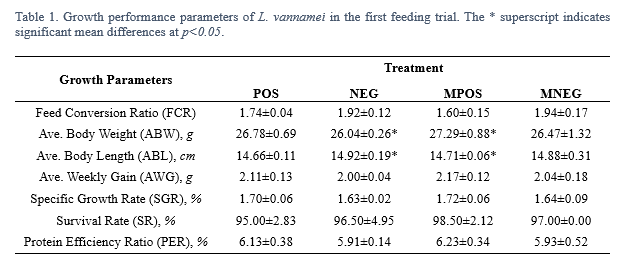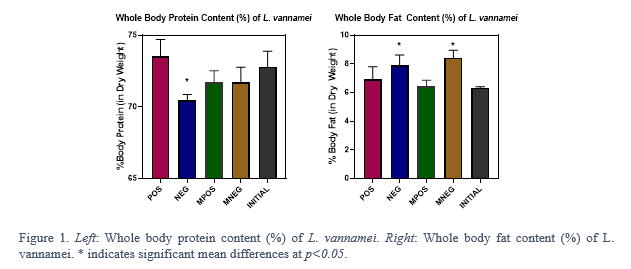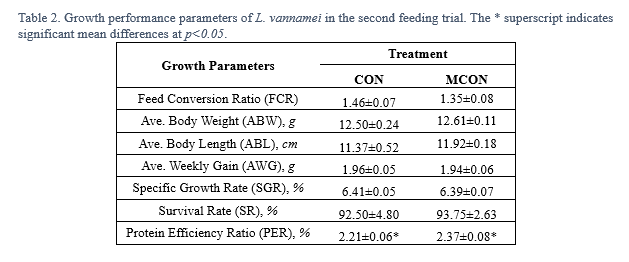PROTEIN-SPARING EFFECTS OF A MODIFIED HIGH FAT DIET IN PACIFIC WHITELEG SHRIMP Litopenaeus vannamei
Introduction
Aquaculture significantly contributes to global seafood production (FAO, 2022) and Litopenaeus vannamei is one of the key aquaculture species due to its adaptability and disease resistance (Danya Babu Ravuru, 2015). However, high feed costs necessitate alternative strategies like protein-sparing, which involves substituting dietary protein with lipids (Wang et al., 2015). This study evaluated the protein-sparing effects of modified diets on the growth performance and metabolic effects on L. vannamei. Diet modification was made by adding the following compounds: L-carnitine, choline chloride, glycerol monolaurate, and lysophospholipids.
Materials and Methods
All diet feeds were produced in-house at VDS, N.V. in Deerlijk, Belgium. The study consisted of two feeding trials conducted over 57 days.
The initial average weight of the shrimp for the first feeding trial was 11.19±0.06 grams. For the second feeding trial, the initial average weight of the shrimp was 0.86±0.00 gram. Shrimps were cultured in a recirculating aquaculture system. Water quality parameters were monitored and controlled to ensure optimal culture conditions. At the end of the feeding trials, growth performance metrics and metabolic effects were determined.
Results
For the first feeding trial (Table 1), the MPOS treatment had significantly higher body weight than the NEG treatment. Other parameters did not show significant differences among the treatments. It is also noteworthy that the MPOS showed better growth performance tendencies, although not significant.
In terms of whole body protein (Figure 1, left), NEG treatment had an expectedly significant lower body protein content (%) compared to other treatments and the initial body protein, indicating low protein assimilation from a low protein diet. This effect was mitigated by the modification of the NEG diet (MNEG). For the whole body fat content (Figure 1, right), there was an expected significant increase of whole body fat of treatments NEG and MNEG. It appears that diet modification did not decrease the body fat of the shrimps.
For the second feeding trial, the results confirmed the previous feeding trial results on POS and MPOS (Table 2). Additionally, the Protein Efficiency Ratio (PER) of MCON was significantly higher than CON treatment.
Conclusion
The diet modification showed best results in a high-protein, low-fat diet of shrimp throughout its growing stage (from 0.8 gram to 27 grams). It also improved some growth parameters and metabolic effects in the low protein, high-fat diet, indicating an amelioration of its negative effects. Additionally, the diet modification demonstrated a protein-sparing effect in the high-fat diet, as confirmed by the whole body protein analysis of the shrimp, although it did not reduce the total body fat content.
References
Danya Babu Ravuru, J. N. M. (2015). Growth of Cultured White Leg Shrimp Litopenaeus Vannamei (Boone, 1931)of Brackish Water Culture System in Winter Season with Artificial Diet. Journal of Aquaculture Research & Development, 06(02). https://doi.org/10.4172/2155-9546.1000304
FAO. (2022). The State of World Fisheries and Aquaculture 2022. Towards Blue Transformation. In The State of World Fisheries and Aquaculture 2022. FAO. https://doi.org/10.4060/cc0461en
Wang, X. D., Li, E. C., Wang, S. F., Qin, J. G., Chen, X. F., Lai, Q. M., Chen, K., Xu, C., Gan, L., Yu, N., Du, Z. Y., & Chen, L. Q. (2015). Protein-sparing effect of carbohydrate in the diet of white shrimp Litopenaeus vannamei at low salinity. Aquaculture Nutrition, 21(6), 904–912. https://doi.org/10.1111/anu.12221









